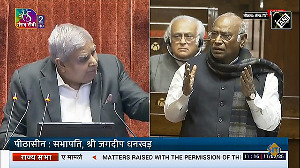Last month's column on SEZs attracted many responses, all of them supportive of the doubts expressed. This is an indication that there are misgivings about the policy even among those who accept the basic premises of a liberalised market economy.
The modifications of the SEZ (special economic zone) policy announced on April 5 do address the issue of fairness in land acquisition though, presumably, the wrongs already committed will not be undone.
The indications are that the law will be amended so that we have a clearer definition of public purpose. The changes also sharpen obligations to assist those who are displaced with the proposed commitment to provide a job to every displaced family (including presumably those who do not own any land). I still believe a separate Act is required for large-scale land purchases specifying these obligations and providing a role for the local community. But at least the government has moved in the right direction.
The modifications do not address the proliferation of SEZs, which matters because each of these will require a bureaucratic machinery to enforce the separation from the domestic tariff area.
China has only six while we are planning more than ten times that already with several hundred waiting for approval. Incidentally while we are imitating China, they are showing a keen interest in our earlier virtual EPZ policy, which did not confuse export promotion and land development.
The SEZ Rules run into 94 pages and are designed to prevent a leakage of concessions to the domestic tariff area and are very elaborate because we have shirked the task of simplification and rationalisation of tariff and tax policies.
To give just one small example of the type of rule that has been found necessary, you will need an authorisation to take a laptop computer out of the SEZ into the domestic tariff area (say, from Gurgaon to New Delhi).
All of this paraphernalia of rules and authorities and approvals will lead inevitably to that cycle of misuse, corruption, media exposes, scandals and prosecutions that we were getting out of when we moved away from the licence-permit regime.
Many of the units that will go to the SEZs would have come up anyway and the net result will be the revenue loss because of the generous tax breaks and the real estate profits for the developers.
Frankly the old EPZ framework was enough for the units that were predominantly export-oriented. It took care of the need for a simple process for immunising exporters from the complexities of our indirect tax structure.
The real challenge is to make the units that serve both exports and the domestic market globally competitive. The competitive pressures of world trade lead to productivity gains. This comes not just from easier imports but also from the spillover of productivity gains from the export production.
In fact the example of auto parts and automobiles shows that there is no real distinction. Enterprises that were restructured to cope with freer imports developed into viable exporting firms. The productivity spillovers have benefited scores of firms. Would this have happened had we gone the SEZ route with new exporting enterprises ensconced in isolated pockets?
Take another example from the services sector. We want Mumbai to develop as an international financial centre. But the Committee that submitted its report recently did not opt for an SEZ type route even though its goal was so geographically specific.
They could have proposed an enclave with full convertibility, a relatively free investment environment for financial enterprises, a separate regulatory regime and no taxes to distort financial transactions.
But the Committee quite rightly did not do that. It came to the correct judgment that an isolated enclave of globally competitive financial units is not viable. The more difficult route of broad-based liberalisation and regulatory and tax reform that it has proposed has the huge advantage of benefiting the economy not just through the income and employment generated in the export of financial services but also through the impact of a more efficient finance industry on the economy as a whole.
The real alternative to the SEZs is a monetary policy that maintains a competitive exchange rate and an industrial policy that generates pressures for productivity improvements.
There are many who argue that the key to further productivity gains lies in changes in labour laws. That is presumably why the SEZ Rules require that state governments delegate powers to the development commissioner of each zone and declare the SEZs public utility services under the Industrial Disputes Act, 1947. (Has the Left Front government in Bengal done that?)
But, judging by the large reductions in the workforce in major auto and steel companies (including the public sector SAIL), constraints on hiring and firing have not stopped restructuring. In any case, the idea that labour laws that weaken workers' rights can be implemented in SEZs even though they are politically unacceptable as a whole is mistaken.
I believe that the key to productivity gains lies in a vigorous competition policy that includes not just competition laws and regulatory regimes for infrastructure but also trade, tax, credit, government procurement and other policies that impinge on matters like freedom of entry and exit, restraint of trade and consumer protection. But here the government seems to be making haste particularly slowly.
The other requirement is the need to extend the restructuring process beyond large corporations to small and medium enterprises. This is where an area-based approach that promotes synergistically linked clusters of enterprises can help. Huge improvements in transport and trade logistics are necessary to level the playing field across the country.
In addition we need a more organised effort to stimulate risk capital for ventures that are trying out new products, processes or business models so that Indian industry gets on with the task of building up a portfolio of intellectual property. Here too there is little evidence of any action by the government and, in the case of venture funding, a step backwards in the recent Budget.
Let us hope that the government does not stop at the SEZs and gets on with the more urgent task of promoting competition and technological dynamism throughout the economy.






 © 2025
© 2025